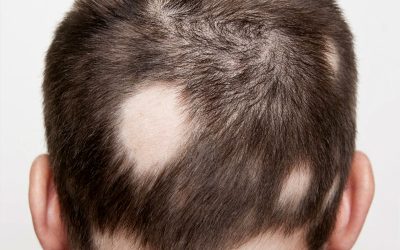SERVICES
- Allergy Screening
- Chemical Peels
- Dermapen
- Facial Skin Analysis
- FreshEyes
- Hyperhidrosis (Excessive Sweating)
- Hair Loss Treatment
- Laser Clinic
- Liquid Facelift
- Keloid Treatments
- Medical Facials
- Medical Treatments
- Mole Mapping
- Photodynamic Therapy (PDT)
- Skincare Advice
- Pigmentation Treatment
- Surgical Procedures
- Ultraviolet Phototherapy
USEFUL LINKS
What is alopecia areata?
 Alopecia is a general term for hair loss. Alopecia areata is a specific, common cause of hair loss that can occur at any age. It usually causes small, coin-sized, round patches of baldness on the scalp, although hair elsewhere such as the beard, eyebrows, eyelashes, body and limbs can be affected. Occasionally it can involve the whole scalp (alopecia totalis) or even the entire body and scalp (alopecia universalis). It is not possible to predict how much hair will be lost. Regrowth of hair in typical alopecia areata is usual over a period of months or sometimes years, but cannot be guaranteed. The hair sometimes regrows white, at least in the first instance. Further hair loss is not uncommon. In alopecia totalis and alopecia universalis, the likelihood of total regrowth is less.
Alopecia is a general term for hair loss. Alopecia areata is a specific, common cause of hair loss that can occur at any age. It usually causes small, coin-sized, round patches of baldness on the scalp, although hair elsewhere such as the beard, eyebrows, eyelashes, body and limbs can be affected. Occasionally it can involve the whole scalp (alopecia totalis) or even the entire body and scalp (alopecia universalis). It is not possible to predict how much hair will be lost. Regrowth of hair in typical alopecia areata is usual over a period of months or sometimes years, but cannot be guaranteed. The hair sometimes regrows white, at least in the first instance. Further hair loss is not uncommon. In alopecia totalis and alopecia universalis, the likelihood of total regrowth is less.
What causes alopecia areata?
Hair is lost because it is rejected by the affected person’s immune system which does not recognise the hair roots (follicles) as “self”, but regards them as “foreign” (autoimmunity). Why this happens is not fully understood, nor is it known why only localised areas are affected and why the hair regrows again.
Someone with alopecia areata is more likely than a person without it to develop other autoimmune conditions such as thyroid disease and vitiligo (white patches on the skin), although the risk of getting these disorders is still low. Your doctor may suggest a blood test looking for antibodies that may predict whether you are likely to develop thyroid problems or pernicious anaemia.
Alopecia areata is not catching nor is it related to diet or vitamin deficiencies. Stress, particularly events such as bereavement, separation and accidents, occasionally appears to be a trigger for alopecia areata.
Is alopecia areata hereditary?
There is a genetic predisposition to alopecia areata and close family members may be affected. Thyroid problems are also common.
What are the symptoms?
There may be a tingling sensation in the scalp. It can be a very upsetting condition to the sufferer, especially if the bald area cannot be disguised by hairstyle.
What does alopecia areata look like?
Typically, it starts as one or more bald, smooth patches on the scalp, which are not inflamed or scaly. It tends to affect the pigmented hair so there may be some white hairs left within the bald area in older people. Sometimes the hair loss is diffuse rather than well-circumscribed patches. Short, tapered hairs, known as exclamation mark hairs that are characteristic of alopecia areata, may be seen at the edge of the bald patch. Regrowth usually starts at the centre of the bald patch with fine white hair that thickens with time and usually regains its colour. Some people with alopecia areata develop small pits on their nails, similar to the dimples seen on a thimble.
Can it be cured?
No, alopecia areata cannot be cured. If the hair loss is patchy, there is a good chance (about 60-80%) that there will be complete regrowth within 1 year without treatment. There may, however, be further episodes of hair loss in the future. If there is very extensive hair loss from the start, the chances of it regrowing may not be as good. In people with Down’s syndrome, or those who have severe eczema, the chances of regrowth are not so good either.
How can alopecia areata be treated?
People with mild early alopecia areata may need no treatment, as their hair is likely to come back anyway without it. Some treatments can induce hair growth, though none is able to alter the overall course of the disease. Any treatments that carry serious risks should be avoided, as alopecia areata itself has no adverse affect on physical health.
The treatments that are available include:
- Steroid creams and scalp applications. These are applied to the bald patches, usually twice a day, for a limited time.
- Local steroid injections. These can be used on the scalp and brows, and are the most effective approach for small patches of hair loss. Injections can be repeated every few months. A small dimple may develop at the injection sites, but this usually recovers after a few months. Special care is taken around the eyes, when injecting the brows, as injecting too much may cause glaucoma (raised pressure inside the eyeball).
- Steroid tablets. Large doses of steroid tablets may result in regrowth of the hair, but when the treatment stops the alopecia often recurs. Taking steroids by mouth over a period of time can cause many side effects including raised blood pressure, diabetes, stomach ulcers, cataracts and osteoporosis as well as weight gain.
- Dithranol cream. This cream, which is usually used to treat another skin condition called psoriasis, causes irritation of the skin, and occasionally this stimulates the hair to regrow when applied to the bald areas. It is safe to use, but stains the skin and hair a purple-brown colour, which is particularly prominent in blond and fair-headed people.
- Contact sensitisation treatment. This involves making the patient allergic to a substance (usually a chemical called diphencyprone) and then applying very weak strengths of this chemical to the bald patches, usually once a week to maintain a mild inflammation. Side effects of possible itching, blistering and enlarged glands in the neck can be troublesome. Loss of skin colour (depigmentation) may develop, so it is used with caution in those with dark skin. This treatment is only available in specialized centres
- Ultraviolet light treatment. This involves taking a tablet or applying a cream that makes the skin sensitive to light, and then exposing the bald patches to ultraviolet light, two or three times a week for a number of months. Relapse of the alopecia is common when the treatment is stopped. There is also a possible long-term risk of skin cancers.
- Minoxidil lotion. This is available over the counter. Applied to the bald patches it may help some sufferers although it seldom produces cosmetically useful regrowth of hair.
Some individuals with alopecia areata will prefer to wear a wig while they wait for recovery. These can either be bought privately, or obtained through the NHS (although a financial contribution is required) on a consultant’s prescription. Your local hospital orthotic (surgical appliances) department will be able to advise you on the range of hairpieces available on the NHS and can recommend local suppliers who are sensitive to the needs of alopecia areata sufferers.
What can I do?
- You may find that joining a patient support group (see below) and meeting other people with alopecia areata will make it easier for you to adjust to your condition.
- Remember that an important function of hair is to protect the scalp from sunlight. You should cover your bald patches with a sun block or a hat to prevent sunburn and also to reduce the chances of developing long-term sun damage.
- If you find that the regrowing hair is slow to recolour, it can be dyed.
Patient Testimonials
EXCELLENTTrustindex verifies that the original source of the review is Google. From my first visit with Dr Jhetam I knew I would go back. He is compassionate , friendly and has an interaction which made you feel comfortable. This is very important in any doctor because our relationship with our doctor is very intimate.Posted onTrustindex verifies that the original source of the review is Google. Dr Jhetman is truly one of a kind. Anyone who is fortunate enough to be in his care can so grateful. Academic, informative and reassuring. It’s hard to find a doctor who has this combination of skills these days. He dealt with my Melonoma concerns with swift and professional care. And his staff are equally as competent and caring. I cannot commend Dr Jhetman and his staff enough on true patient care. Thank you!Posted onTrustindex verifies that the original source of the review is Google. I was absolutely satisfied with my experience with Dr Jhetham & his winning team. Keep up the good work.Posted onTrustindex verifies that the original source of the review is Google. Best skin doctor..Dr Jetham prescribed the best products that have brought so much of a glow to my skin..being a transplant patient and so much happening to my skin just 4 visits to him and my face is back to it's radiance ..I hightly reccomend Dr Jetham ...you won't go wrong..Posted onTrustindex verifies that the original source of the review is Google. Dr. Imraan Jhetam and his team provided exceptional care, showcasing professionalism and compassion in every interaction. Dr. Jhetam took the time to thoroughly explain everything, addressing each of my concerns with empathy and understanding. My experience with him was truly wonderful, and I highly appreciate his dedication to patient care.Verified by TrustindexTrustindex verified badge is the Universal Symbol of Trust. Only the greatest companies can get the verified badge who has a review score above 4.5, based on customer reviews over the past 12 months. Read more



